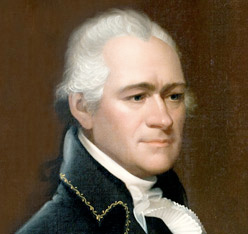 Article VI’s first clause was a bit of housekeeping in reassuring creditors of the United States that they would be paid by the new government formed under the Constitution. The third clause ensured that the government of the country would be secular and office holders at all levels of government would swear loyalty to the Constitution. The second clause, the Supremacy Clause, has the most continuing effect to the modern day.
Article VI’s first clause was a bit of housekeeping in reassuring creditors of the United States that they would be paid by the new government formed under the Constitution. The third clause ensured that the government of the country would be secular and office holders at all levels of government would swear loyalty to the Constitution. The second clause, the Supremacy Clause, has the most continuing effect to the modern day.
Reassurance of the Country’s Creditors
The new nation of the United States had borrowed millions of dollars to finance the revolution. The United States borrowed much of this money from the Dutch and French, arranged by the revolutionary financier, Haym Salomon. The foreign creditors needed assurance that a change in government would not affect the debts owed to them. The result was the following appearing in the Constitution:
“All Debts contracted and Engagements entered into, before the Adoption of this Constitution, shall be as valid against the United States under this Constitution, as under the Confederation. “
Office Holders’ Oath and Prohibition on Religious Tests for Office
The Constitution was ratified and went into operation before the guarantee of religious freedom was added as Amendment I. The Framers wanted to ensure that the government would not require a religious litmus test for office holders. To ensure that not only the federal government, but also the governments of the States would be secular, office holders throughout the country were required to support the Constitution. To address these two concerns, this Article VI clause was included:
“The Senators and Representatives before mentioned, and the Members of the several State Legislatures, and all executive and judicial Officers, both of the United States and of the several States, shall be bound by Oath or Affirmation, to support this Constitution; but no religious Test shall ever be required as a Qualification to any Office or public Trust under the United States.”
As a result, all government officials across the United States who take an oath of office swear or affirm to support the Constitution. This includes state judges, county prosecutors and library board members. Attorneys swear fidelity to the US Constitution as part of being admitted to practice law.
The Supremacy Clause
Article VI, clause 2 makes the Constitution, laws passed by Congress and treaties of the United States the supreme law of the land. This is the Supremacy Clause. The Supremacy Clause establishes federal law as the highest form of law in the United States legal system, requiring that state judges to defer to federal law even if state laws or constitutions conflict. The Constitution mandates:
“This Constitution, and the Laws of the United States which shall be made in Pursuance thereof; and all Treaties made, or which shall be made, under the Authority of the United States, shall be the supreme Law of the Land; and the Judges in every State shall be bound thereby, any Thing in the Constitution or Laws of any State to the contrary notwithstanding.”
If Congress passes a law pursuant to the powers enumerated in Article I, then state law must defer. Even State constitutions are subordinate to federal statutes and treaties. This constitutional mandate is called preemption.
When a State law is challenged as unconstitutional based upon the Supremacy Clause the Supreme Court must decide if the law comports with the policy set out in federal law. The Court’s decision is guided by the manner in which Congress addressed the subject matter in relation to the States. Congress may do this in one of three ways:
- Provide for Exclusive Federal Control. If Congress expresses in the law that it intends to control a specific subject matter and that subject matter is within the authority granted in Article I, then State law in that area is preempted.
- Provide for Concurrent Federal-State Jurisdiction. In some areas, Congress may determine that a subject is appropriate for both federal and State regulation, and expressly provide for concurrent jurisdiction in the law.
- Remain Silent Regarding Jurisdiction. If Congress has not stated its preference, it becomes up to the Supreme Court to decide if the subject matter is under the exclusive control of the federal government.
Hierarchy of Law Created by Supremacy Clause
 The Supremacy Clause lists four classes of law in a specific order. This was not an accident. There is a common misconception that because treaties are listed in the Supremacy Clause they stand on an equal footing with the Constitution. The order of listing and qualifications placed upon each class of law is meaningful. The hierarchy is as follows:
The Supremacy Clause lists four classes of law in a specific order. This was not an accident. There is a common misconception that because treaties are listed in the Supremacy Clause they stand on an equal footing with the Constitution. The order of listing and qualifications placed upon each class of law is meaningful. The hierarchy is as follows:
- The Constitution is listed first and consequently is supreme over other laws of the land.
- Laws passed pursuant to the Constitution are listed second. The qualification of pursuant is critical, because as Alexander Hamilton wrote in Federalist No. 33 that laws not authorized by the Constitution: “...would not be the supreme law of the land, but a usurpation of power not granted by the Constitution…”
- Treaties made under the authority of the United States are listed third. A treaty must be approved pursuant to Art. II, sec. 2, negotiated by the President and consented to by 2/3 of the Senate. However, as treaties are listed third, any changes required in the domestic law of the United States, still requires action by the Senate and House with the signature of the President as provided in Art. I, sec. 7.
- State constitutions and laws are listed fourth and state judges are required to follow federal law when state and federal law are in conflict.






[…] Article VI, The Legal Status of the Constitution […]